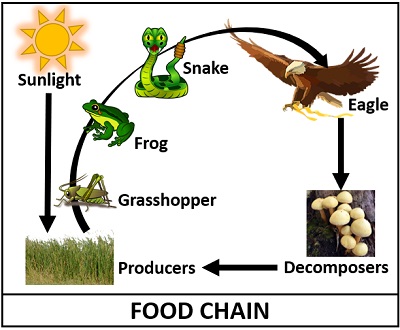CBSE Class 10 Science Chapter 15 Revision Notes
Chapter 15: Our Environment Revision Notes
Mode of nutrition in animals and plants
Autotrophic and Heterotrophic
Saprophytes and decomposers
- Plants, fungi, and microbes that feed on dead and decaying matter are known as saprophytes.
- Decomposers are organisms that break down organic materials or trash and release nutrients into the soil.
- Bacteria, worms, slugs, and snails are examples.
Abiotic components
Chemical and physical components of the environment that are not living, such as soil, air, water, temperature, and so on.
Biotic components
Plants, animals, microorganisms, and fungus are examples of living entities in the environment.
ECOSYSTEM
- Both biotic and abiotic elements are present.
- All living things, such as plants, animals, and creatures, interacting with each other and their non-living environs, such as weather, earth, sun, soil, climate, and atmosphere, in a specific region.
Trophic levels
- It describes the many tiers of a food web in terms of energy flow.
The various trophic levels are as follows:
- Those in charge of production (T1)
- Primary consumers (herbivores-T2)
- Secondary consumers (primary carnivores -T2)
- Tertiary consumers(Sec carnivores -T3)
- Quaternary consumers (Ter. carnivores T4)
Decomposers
- It might be a number pyramid, a biomass pyramid, or an energy pyramid.
- Producers are at the base of all pyramids.
- a) The number of creatures present at each trophic level is represented by a pyramid of numbers.
- It might be inverted or upright.
- b) Biomass pyramid: shows the biomass of each trophic level and can be inverted or upright.
- c) Energy pyramid: is always vertical because it depicts the flow of energy from one trophic level to the next.
The law of energy conservation
- Energy does neither generate or destroy itself; instead, it transitions from one form to another.
- It is transferred from one organism to the next through trophic levels in biological systems.
Flow of energy
- The direction and amount of energy transfer from one trophic level to another is depicted.
- The energy pyramid can be used to symbolise this.
- Only 10% of energy is transmitted from one trophic level to the next in any food chain.
Food chain
-
A symbiotic relationship between organisms that rely on one another for nourishment.
 source: Food web
source: Food web -
It is made up of the linkages of many food chains.
-
Is a graphical depiction of an ecosystem’s ‘Who Eats Whom’.
Characteristics of ecosystem
- The trophic levels are summarised.
- Their pyramids and energy flow.
Environment
- All living and nonliving objects are included.
- In contrast to ecosystems, there is no requirement for interaction between them.
POLLUTION
Air pollution
- Pollutants, organic compounds, and other harmful chemicals are released into the atmosphere.
Sources:
- Natural occurrences such as forest fires, dust storms, and volcanic eruptions
- Power plants, residences, industry, oil refineries, and transportation are examples of man-made structures.
Depletion of the ozone layer
- The ozone layer shields the planet from ultraviolet (UV) radiation from the sun.
- When CFCs are discharged into the atmosphere, they react chemically with ozone molecules, causing the layer to deplete.
Garbage disposal
- All of the activities and actions necessary to manage trash from its conception to final disposal are included.
- Ensures that environmental best practises, as well as necessary monitoring and regulation, are followed.
The following are the steps involved:
-
Waste segregation
-
Collection
-
Transport
-
Treatment
-
Recycling and processing
-
Disposal
Biodegradable waste
- Plant or animal waste is a type of waste.
- Weather, water, air, heat, microorganisms, and other natural agents decompose it into the soil.
Biodegradation
- Garbage or waste material decomposition by live creatures or biological processes.
